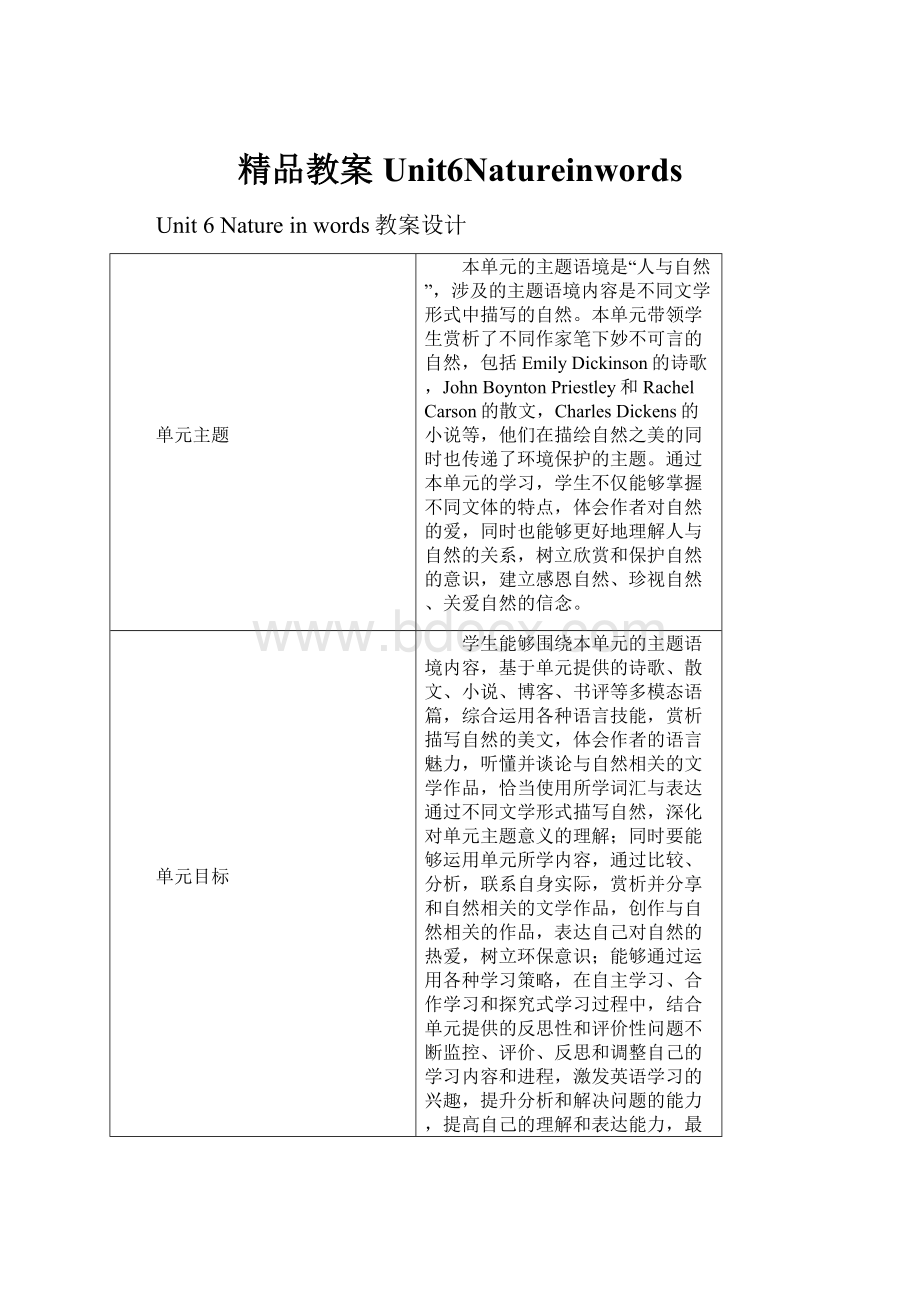精品教案Unit6Natureinwords.docx
《精品教案Unit6Natureinwords.docx》由会员分享,可在线阅读,更多相关《精品教案Unit6Natureinwords.docx(25页珍藏版)》请在冰豆网上搜索。

精品教案Unit6Natureinwords
Unit6Natureinwords教案设计
单元主题
本单元的主题语境是“人与自然”,涉及的主题语境内容是不同文学形式中描写的自然。
本单元带领学生赏析了不同作家笔下妙不可言的自然,包括EmilyDickinson的诗歌,JohnBoyntonPriestley和RachelCarson的散文,CharlesDickens的小说等,他们在描绘自然之美的同时也传递了环境保护的主题。
通过本单元的学习,学生不仅能够掌握不同文体的特点,体会作者对自然的爱,同时也能够更好地理解人与自然的关系,树立欣赏和保护自然的意识,建立感恩自然、珍视自然、关爱自然的信念。
单元目标
学生能够围绕本单元的主题语境内容,基于单元提供的诗歌、散文、小说、博客、书评等多模态语篇,综合运用各种语言技能,赏析描写自然的美文,体会作者的语言魅力,听懂并谈论与自然相关的文学作品,恰当使用所学词汇与表达通过不同文学形式描写自然,深化对单元主题意义的理解;同时要能够运用单元所学内容,通过比较、分析,联系自身实际,赏析并分享和自然相关的文学作品,创作与自然相关的作品,表达自己对自然的热爱,树立环保意识;能够通过运用各种学习策略,在自主学习、合作学习和探究式学习过程中,结合单元提供的反思性和评价性问题不断监控、评价、反思和调整自己的学习内容和进程,激发英语学习的兴趣,提升分析和解决问题的能力,提高自己的理解和表达能力,最终促进自身语言能力、文化意识、思维品质和学习能力的综合提升。
Startingout板块教学设计
(建议时长30-45分钟,教师可根据教学实际酌情调整。
)
课型
Viewing+Listening+Reading+Speaking
主题语境
人与自然—感恩自然、珍视自然、关爱自然
内容分析
活动1呈现了一段与单元主题相关的视频,介绍了中西方以自然为主题的文学作品的发展史,特别提到了现代作家用笔墨唤醒人们保护自然的写作目的。
活动2请学生阅读EmilyDickinson的诗歌NatureisWhatWeSee,感受作者对自然的爱和欣赏。
本板块旨在激活学生已有的背景知识和语言知识,为接下来整个单元的学习活动做铺垫和预热。
教学目标
1.学生通过观看视频了解和自然主题相关的不同文学形式的发展历史、代表作、写作风格和内容,激活学生已有的背景知识和语言知识;
2.学生通过听读诗歌,分析我们看到、听到的自然景象,分析这些景象的特点,品味这些形象的寓意,初步赏析诗歌,理解作者传达的态度和观点;
3.学生通过讨论和自然相关的文学作品和自然的意义,对单元话题进行导入,产生对自然的敬畏感。
教学重点
1.引导学生通过赏析诗歌,理解作者所传达的对自然的态度和观点;
2.引导学生通过看到、听到的自然景象,分析其特点、品味及寓意。
教学难点
1.引导学生激活已有的背景知识和语言知识;
2.引导学生初步形成对自然的敬畏感。
教学策略
在看、听、读前引领学生关注需获取的信息点,过程中用note-taking的方式记录,引导学生交流、讨论诗歌中作者利用image传递的信息及寓意。
Teachingcontents
Procedures
Purposes
Teacher’sactivity
Ss’activity
Activity1
1.TinvitesSstointroducetheliteraryformstheyknow.
2.TplaysthevideoandasksSstoanswerQuestions1-2inActivity1.
3.TplaysthelastpartofthevideoandasksSswhymodernwriterschangetheirperspectiveofdescribingnature.
1.Ssexchangewhattheyknowaboutliteraryformstoeachother.
2.Ssanswerthequestions.
3.Ssunderstandthemainideaofthelastpartandunderstandwhymodernwriterschangetheirperspectiveofdescribingnature.
HelpSsunderstandthevideo.
HelpSsgettoknowthecommonliteraryforms.
BringSstothetopic.
Activity2
1.TplaysthetapeandasksSstoreadwiththetapeandanswerQuestion1inActivity2.
2.TasksSstodiscusstheanswerstoQuestion1ingroupsandthenreadthepoemagaintoanswerQuestion2-3inActivity2.
3.TasksSstoreadagainanddiscusstogetthemeaningofthelasttwosentences.
1.SsreadthepoemwiththetapeandanswerQuestion1inActivity2.
2.SsfirstdiscussandthenanswertheQuestion2-3inActivity2.
3.Ssdiscussandsharetheirideas.
HelpSsgetwhatnatureisbytheimagesinthepoem.
Getwhatthepoetconveys.
GetSstoformandexpressthepersonalunderstandingofthepoem.
Understandingideas板块教学设计
(建议时长60–90分钟,教师可根据教学实际酌情调整。
)
课型
Reading+Speaking
主题语境
人与自然—感恩自然、珍视自然、关爱自然
内容分析
本板块呈现了一篇英国作家JohnBoyntonPriestley的《初雪》,作者把下雪视为一件“神奇的大事件”,通过形象生动的语言描写了冬天的第一场雪,表达了自己对雪的热爱,营造了人与自然和睦共存的景象。
读前的导入活动介绍了JohnBoyntonPriestley的生平及代表作,要求学生通过回答问题和继续搜索资料,了解作家的信息,旨在帮助学生熟悉写作背景,为接下来的课文学习做铺垫。
读中活动请学生描写初雪的表达,进一步赏析文章。
读后活动则通过理解作者的写作目的,分析写作思路和回答开放性问题等活动,帮助学生深入理解课文,赏析课文,探究主题意义,培养思维能力。
教学目标
1.学生通过了解作者的生平信息,更有效地理解课文中作者想要表达的观点和写作意图;
2.学生通过略读和精读,获取课文大意,并引导学生通过语言知识的学习、写作线索的捕捉及作者写作手法的分析,理解作者对雪的描写及传达的情感;
3.学生通过将课文内容转换成视觉信息的形式,更好地理解文本信息,同时联想并分享更多描写雪的文学作品。
教学重点
引导学生理解作者对雪的描写及传达的情感。
教学难点
引导学生捕捉写作线索、分析作者的写作手法。
教学策略
按照时间线索理解文章内容,品味作者语言的魅力,划出描写雪的神奇的词或短语,划出关键词等。
Teachingcontents
Procedures
Purposes
Teacher’sactivity
Ss’activity
Activity1
1.TasksSstoreadthebriefintroductiontothewriterandfinishQuestion1.
2.TasksSstosurftheInternettolookforsomeinformationaboutthewriterandfinishQuestion2.
1.SsreadthebriefintroductiontothewriterandanswerQuestion1.
2.SssearchfortheinformationbythemselvesandanswerQuestion2.
HelpSsgetinformationaboutthewriter.
HelpSsunderstandthepassagebetterbyunderstandingthewriter’swritingbackgroundandpersonality.
Activity2
1.TasksSstodescribesnowusingtheirownlanguageandexchangetheirdescriptioningroups.
2.TasksSstoreadthepassageandunderlinethewordsorphraseswhichareusedtodescribethesnow.
1.Sswritedownsentencesorphrasesorwordstodescribesnow.
2.Ssreadandunderlinethewordsorphraseswhichareusedtodescribethesnow.
DevelopSs’languageability.
HelpSsunderstandthewriter’sdescriptionofFirstSnow.
Activity3
1.TasksSstoreadthethreegivenchoicesandlocatethekeyinformationofeachone.
2.TasksSstoreadandfindouthowthewriterexpresses“Thefirstfallofsnowisnotonlyaneventbutitisamagicalevent.”
3.TasksSstoreadandfindouthowthewriterexpresses“thechangeofthesurroundingsafterthesnow”.
4.TasksSstoreadanddiscusswhythewriterusesthechildrenrhymeattheendofthepassage.
5.TasksSstofinishActivity3andchecktheanswer.
1.Ssreadandlocatethekeyinformationineachchoice.
2.Ssreadandunderlinethekeywordsofhowthewriterexpresses“Thefirstfallofsnowisnotonlyaneventbutitisamagicalevent.”
3.Ssreadandunderlinethekeywordsofhowthewriterexpresses“thechangeofthesurroundingsafterthesnow”.
4.Ssreadandexpresstheirownidea.
5.SsfinishActivity3.
TrainSs’abilitytounderstandthewriter’swritingpurpose.
GetSstounderstandthewriter’swritingstylebyappreciatingthelanguageused.
Activity4
1.TasksSstoreadparagraphs3to5andcompletethediagraminActivity4accordingtothetimeline.
2.TcheckstheanswerandasksSstoretellthesnowsceneryaccordingtothetimeline.
3.TasksSstoretellingroups,letsonestudenttoretellandtheothergroupmemberstakenotesordrawpictures.
1.Ssreadparagraphs3to5andcompletethediagraminActivity4.
2.Ssretellthesnowsceneryaccordingtothetimeline.
3.Ssretellaccordingtothetimelineortakenotesordrawpictures.
TrainSs’abilitytogetthespecificinformationbasedonthetimeline.
TrainSstoretellthestorybyusingtheinformationtheyget.
GetSstolearntouseproperstructuretotellastoryorwriteapassage.
Think&Share
TasksSstoworkinpairsandtalkabouthowtheauthororganisesthestructureofthepassage.
SstalkabouthowtheauthororganisesthestructureofthepassageinpairsaccordingtothecluesinThink&Share.
TrainSs’abilitytoexpresstheirideasinalogicalway.
UsingLanguage板块教学设计
(建议时长80–100分钟,教师可根据教学实际酌情调整。
)
课型
Reading+Listening+Speaking+Writing
主题语境
人与自然——感恩自然、珍视自然、关爱自然
内容分析
本板块围绕单元话题,通过多模态的形式,引导学生通过语篇活动、听说训练等内容,学习语法知识及相关词汇和表达,从不同方面开拓视野,提升语言运用能力,进一步理解单元主题。
语法部分的主要内容为复习非谓语动词作定语、状语、补语的功能和意义。
在引导学生归纳总结课文中该语法用法的同时,通过介绍湖畔诗人的小语篇和旅游日记,谈论自己的旅游经历等内容复习和巩固非谓语动词的用法。
综合语言运用部分的话题为“描述自然”,涉及CharlesDickens笔下的魅力八月和时代变迁下字典中消失的一些描述自然的词汇等内容,帮助学生深度聚焦语言的意义和功能,在真实语境下进行思考和交际运用,全方位提升综合语言运用能力。
教学目标
1.学生总结非谓语动词的意义,复习非谓语动词作定语、状语和补语的用法,学会在写作中正确使用非谓语动词;
2.学生学习并运用描写自然的词汇,按照声音、颜色、动作、形状、气味和感觉进行词汇分类,并找到更多类似的词语;
3.学生关注语用功能,学会区分有关“举例子”和“做解释”的表达,,并能够在实际生活中运用这些表达。
教学重点
引导学生得体地使用非谓语动词描写自然。
教学难点
引导学生在真实任务情境中运用列举和解释得体表达。
教学策略
语境中习得语法、通过归类学习和拓展词汇、在听对话中注意记录关键信息。
Teachingcontents
Procedures
Purposes
Teacher’sactivity
Ss’activity
Activity1
1.TasksSstoreadthefoursentencesfromthereadingpassage,payattentiontothelogicalsubjectandfunctionofthewordsinboldandthenfinishQuestion1-3.
2.TasksSstodiscusstheanswersingroupsandclassifynon-finiteformsasattributive,adverbialandcomplement.
3.TasksSstoreadthetexttofindmoresentenceswithnon-finiteformsthatperformthefunctionsofotherformsofwordslikeadjectives,nounsoradverbs.
1.Ssreadthefoursentences,determinethelogicalsubjectofthewordsinboldandtheirfunctionsandthenfinishQuestion1-3.
2.Ssdiscusstheansweringroupsandclassifynon-finiteformsasattributive,adverbialandcomplement.
3.Ssreadthetexttofindmoresentenceswithnon-finiteformsthatperformthefunctionsofotherformsofwords.
GetSstoknownon-finiteformsasattributive,adverbialandcomplementinthecontext.
HelpSsunderstandnon-finiteformsinthecontext.
Activity2
1.TasksSstocompletethepassageaccordingtothecontext.
2.TasksSstoreadthepassageandchecktheanswers.
1.Ssreadthepassageandfillintheblanks.
2.Ssreadandchecktheanswers.
HelpSsusenon-finiteformsinthecontext.
Activity3
1.TdividesSsintogroupsandaskseverystudenttomakeupasentenceaccordingtothegivenpictureandverbsandencouragesSstousenon-finiteformsasmuchaspossible.
2.TasksSsineachgrouptoreadtheirsentenceonebyoneandcompleteadiary.
3.TasksSstoenhancethediarybasedonwhattheyhavelearntandaddmoredetaileddescription.
1.Ssconstructsentencesaccordingtothegivenverbstodescribethepicture.
2.Ssineachgroup
readtheirsentenceonebyoneandcompleteadiary.
3.Ssenhancethediarybasedonwhattheyhavelearntandaddmoredetaileddescription.
GetSstobefamiliarwithusingnon-finiteforms.
GetSstodescribethepictureusingnon-finiteverbs.
GetSstoimproveontheirdiary.
Activity4
1.TasksSstoworkinpairstotalkabouttheirowntravelexperiencewhichisrelatedtonature,usingnon-finiteformsasmuchaspossible.
2.TinvitesafewSstosharetheirowntravelexperiencewiththeclass.
3.TgivessuggestionstoSsaboutusingthenon-finitewordsinanalternativeway.
1.Sstalkabouttheirexperienceinpairsandtrytousenon-finiteformsasmuchaspossible.
2.Sscometothefrontoftheclasstosharetheirtravelexperience.
3.Sssummariseandtakenotes.
TrainSstotalkabouttheirtravelexperienceusingwhattheyhavelearnt.
Activity5
1.TasksSstoreadtheparagraphandhaveageneralunderstanding.
2.TasksSstodiscussQuestions1-2ingroups.
3.Tinvites